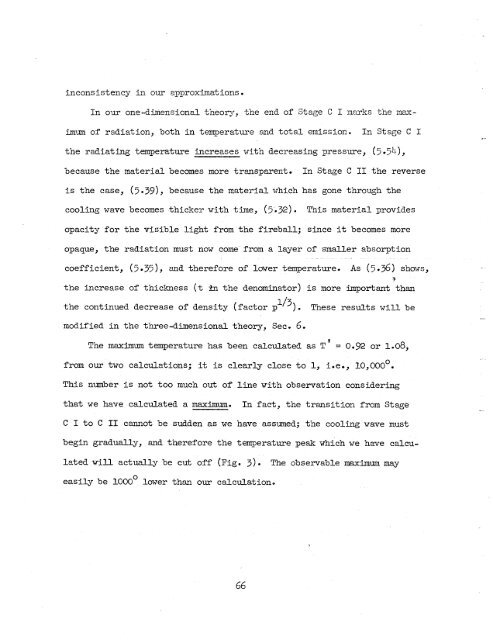Theory of the Fireball
Theory of the Fireball
Theory of the Fireball
Create successful ePaper yourself
Turn your PDF publications into a flip-book with our unique Google optimized e-Paper software.
inconsistency in our apyroximations .<br />
In our one-diniensional tneoqy, tne end <strong>of</strong> Stage C I narks -<strong>the</strong> max-<br />
Snrrm. <strong>of</strong> radiation, both in temperature and total emission. In Stage C I<br />
because <strong>the</strong> material becomes more transparent. In Stage C I1 <strong>the</strong> reverse<br />
is <strong>the</strong> case, (5.39), because <strong>the</strong> material which has gone through <strong>the</strong><br />
cooling wave becomes thicker with time, (5,.32). Tnis material provides<br />
opacity for <strong>the</strong> visible light from <strong>the</strong> fireball; since it becomes more<br />
opaque, <strong>the</strong> radiation must now come from a layer <strong>of</strong> smaller absorption<br />
coefficient, (5.35), and <strong>the</strong>refore <strong>of</strong> lower temperature. As (5.36) sha~s,<br />
<strong>the</strong> increase <strong>of</strong> thickness (t 2n <strong>the</strong> denominator) is more important than<br />
<strong>the</strong> continued decrease <strong>of</strong> density (factor p 1/3 ). Tnese results will be<br />
modified in <strong>the</strong> three-dimensional <strong>the</strong>ory, Sec. 6.<br />
1<br />
The maximum temperature has been calculated as T = 0.92 or 1.08,<br />
from om two calculations; it is clearly close to 1, i.e., ~O,OOO~.<br />
This number is not too mucn out <strong>of</strong> line with observation considering<br />
tnat we have calculated a maximum. In fact, tne transition from Stage<br />
C I to C I1 cannot be sudden as we have assumed; <strong>the</strong> cooling wave must<br />
begin gradually, and tnerefore <strong>the</strong> temperature peak which we have calcu-<br />
lated will actually be cut <strong>of</strong>f (Fig. 3). The observable maximum may<br />
easily be 1000° lower than our calculation.<br />
66<br />
k
















